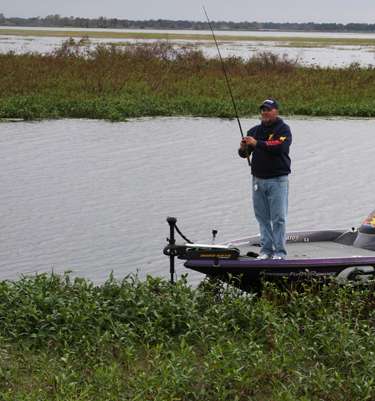
Florida bass angler Tom Morse has made his mark in the fishing industry pitching and flipping mats for big, heavyweight largemouths. His approach is somewhat different, very precise and requires a fair amount of concentration. Nevertheless, those anglers who are willing to work his system will likely catch more bass this year, and not just in Florida.
We asked him to detail his theories, his approach and his tackle choices. Here's what he had to say.
Let's talk first about selecting a productive mat. My preference is for smaller mats — maybe 20 feet by 20 feet — with a mixture of vegetation in them. I like some reeds, some hydrilla and maybe a few hyacinths mixed in for good measure. A big gator vine or two doesn't hurt, either.
I believe this type of mat is productive because it attracts smaller baitfish and affords bass an excellent ambush point. They hang in the middle of the mat and grab the little fish as they enter into the shade.
When the water's cold, most of the bass will hang near the bottom. As the water warms, and especially if the sun's out, they'll move up in the water column until they're right under the floating vegetation. Either way they're vulnerable to a properly presented plastic bait.
I begin fishing a mat by pitching and flipping to the outside edges. Active bass will dart out from the middle and grab your bait as it falls. If that isn't successful I move in toward the center of the mat and try to drop it right on their nose.
Depending upon the thickness of the mat — and the size of the bass I expect to catch — I use three basic outfits. The first, and lightest, begins with a 7-foot Deep South medium-heavy fast taper rod. The fast taper is critical. It allows me to feel the bass before he feels me.
I mount a Daiwa Zillion reel (7.1:1 gear ratio) on it, spooled with 17-pound-test Gamma copolymer line (clear). The high-speed reel lets me get a bass moving in my direction quickly. A bass should come out of the same hole the lure went in, otherwise he'll wrap you around something and shake lose sure as the devil. You can't move him fast enough with a low gear ratio reel.
My line choice is a little controversial. I know everyone talks about pitching and flipping with braid. I don't buy it. High-quality copolymer has less resistance, less memory and is just as strong in my opinion. And, it's clear. The fish never see it like they would braid.
My bait choice is a Gambler Crawdaddy in junebug. For some reason here in Florida the best colors seem to be junebug and a black and blue combination. It might be different in other parts of the country. Don't hesitate to experiment. Sometimes color can make a big difference.
My hook choice is a MiHatchii Flipping Hook, or their Little Flip for smaller baits. They're a part of the Fish Harder family and, in my opinion, the best pitching and flipping hooks on the market. I weight everything with a Tru-Tungsten worm weight and peg it with a Peter T Smart Peg.
Pegging your weight is important. If the weight separates from the plastic it'll result in the plastic lying on top of the mat and the weight falling under it. Bass rarely hit a falling piece of tungsten, and even if they do you can't hook them.
As I move in on the mat, or if it's particularly thick, I'll upsize my tackle but stay with the same manufacturers. My choice is a 7-foot, 6-inch soft flipping stick, the same reel and heavier line depending upon the conditions.
My bait size usually increases to a 4-inch Gambler Ugly Otter. My hook style stays the same, but I increase my weight and swap the worm weight design for a Denny Brauer Flippin' Weight.
My third outfit is even heavier. My rod is a heavy, stiff 7-foot, 6-inch model, and my Gamma line goes to 25-pound test. On this rig I might move my weight up into the 1 1/2-ounce range — still a Denny Brauer Flippin' Weight with a Peter T Smart Peg to hold everything in place.
Always match the size of your hook to the size of your plastic bait. If the hook's too small you won't hook the fish. If it's too big it'll hang on the vegetation as it falls through the mat.
One final note: Skin-hook all your plastics. If you leave the hook point exposed you'll hang on every cast. If you use a true Texas rig you'll miss too many bites.
Give mats a fresh look this year. No matter where you live or where you fish, they'll hold bass — maybe the one of a lifetime.




